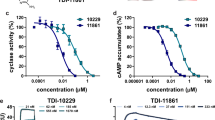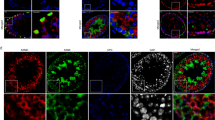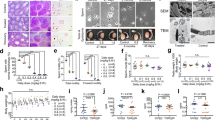Abstract
Throughout spermatogenesis, developing germ cells remain attached to Sertoli cells via testis-specific anchoring junctions. If adhesion between these cell types is compromised, germ cells detach from the seminiferous epithelium and infertility often results. Previously, we reported that Adjudin is capable of inducing germ cell loss from the epithelium. In a small subset of animals, however, oral administration of Adjudin (50 mg per kg body weight (b.w.) for 29 d) resulted in adverse effects such as liver inflammation and muscle atrophy. Here, we report a novel approach in which Adjudin is specifically targeted to the testis by conjugating Adjudin to a recombinant follicle-stimulating hormone (FSH) mutant, which serves as its 'carrier'. Using this approach, infertility was induced in adult rats when 0.5 μg Adjudin per kg b.w. was administered intraperitoneally, which was similar to results when 50 mg per kg b.w. was given orally. This represents a substantial increase in Adjudin's selectivity and efficacy as a male contraceptive.
This is a preview of subscription content, access via your institution
Access options
Subscribe to this journal
Receive 12 print issues and online access
$209.00 per year
only $17.42 per issue
Buy this article
- Purchase on Springer Link
- Instant access to full article PDF
Prices may be subject to local taxes which are calculated during checkout




Similar content being viewed by others
References
Mruk, D.D. & Cheng, C.Y. Sertoli-Sertoli and Sertoli-germ cell interactions and their significance in germ cell movement in the seminiferous epithelium during spermatogenesis. Endocr. Rev. 25, 747–806 (2004).
Cheng, C.Y. et al. AF-2364 [1-(2,4-dichlorobenzyl)-1H-indazole-3-carbohydrazide] is a potential male contraceptive: a review of recent data. Contraception 72, 251–261 (2005).
Lee, N.P.Y., Mruk, D.D., Conway, A.M. & Cheng, C.Y. Zyxin, axin, and Wiskott-Aldrich Syndrome Protein are adaptors that link the cadherin/catenin protein complex to the cytoskeleton at adherens junctions in the seminiferous epithelium of the rat testis. J. Androl. 25, 200–215 (2004).
Mruk, D.D. & Cheng, C.Y. Cell-cell interactions at the ectoplasmic specialization in the testis. Trends Endocrinol. Metab. 15, 439–447 (2004).
Cheng, C.Y. & Mruk, D.D. Cell junction dynamics in the testis: Sertoli-germ cell interactions and male contraceptive development. Physiol. Rev. 82, 825–874 (2002).
Cheng, C.Y. et al. Two new male contraceptives exert their effects by depleting germ cells prematurely from the testis. Biol. Reprod. 65, 449–461 (2001).
Grima, J., Silvestrini, B. & Cheng, C.Y. Reversible inhibition of spermatogenesis in rats using a new male contraceptive, 1-(2,4-dichlorobenzyl)-indazole-3-carbohydrazide. Biol. Reprod. 64, 1500–1508 (2001).
Toyama, Y., Maekawa, M. & Yuasa, S. Ectoplasmic specializations in the Sertoli cell: new vistas based on genetic defects and testicular toxicology. Anat. Sci. Int. 78, 1–16 (2003).
Siu, M.K.Y., Mruk, D.D., Lee, W.M. & Cheng, C.Y. Adhering junction dynamics in the testis are regulated by an interplay of β1-integrin and focal adhesion complex-associated proteins. Endocrinology 144, 2141–2163 (2003).
Lui, W.Y., Lee, W.M. & Cheng, C.Y. Sertoli-germ cell adherens junction dynamics in the testis are regulated by RhoB GTPase via the ROCK/LIMK signaling pathway. Biol. Reprod. 68, 2189–2206 (2003).
Griswold, M.D., Heckert, L. & Linder, C. The molecular biology of the FSH receptor. J. Steroid Biochem. Mol. Biol. 53, 215–218 (1995).
Sprengel, R., Braun, T., Nikolics, K., Segaloff, D.L. & Seeburg, P.H. The testicular receptor for follicle stimulating hormone: Structure and functional expression of cloned cDNA. Mol. Endocrinol. 4, 525–530 (1990).
Walker, W.H. & Cheng, J. FSH and testosterone signaling in Sertoli cells. Reproduction 130, 15–28 (2005).
Rose, M.P., Gaines Das, R.E. & Balen, A.H. Definition and measurement of follicle stimulating hormone. Endocr. Rev. 21, 5–21 (2000).
Bishop, L.A., Nguyen, T.V. & Schofield, P.R. Both of the β-subunit carbohydrate residues of follicle-stimulating hormone determine the metabolic clearance rate and in vivo potency. Endocrinology 136, 2635–2640 (1995).
Bishop, L.A., Robertson, D.M., Cahir, N. & Schofield, P.R. Specific roles for the asparagine-linked carbohydrate residues of recombinant human follicle stimulating hormone in receptor binding and signal transduction. Mol. Endocrinol. 8, 722–731 (1994).
Flack, M.R., Froehlich, J., Bennet, A.P., Anasti, J. & Nisula, B.C. Site-directed mutagenesis defines the individual roles of the glycosylation sites on follicle-stimulating hormone. J. Biol. Chem. 269, 14015–14020 (1994).
Valove, F.M., Finch, C., Anasti, J.N., Froehlich, J. & Flack, M.R. Receptor binding and signal transduction are dissociable functions requiring different sites on follicle-stimulating hormone. Endocrinology 135, 2657–2661 (1994).
Blithe, D.L. & Iles, R.K. The role of glycosylation in regulating the glycoprotein hormone free α-subunit and free β-subunit combination in the extraembryonic coelomic fluid of early pregnancy. Endocrinology 136, 903–910 (1995).
Thotakura, N.R. & Blithe, D.L. Glycoprotein hormones: glycobiology of gonadotrophins, thyrotrophin and free α subunit. Glycobiology 5, 3–10 (1995).
Zhang, J., Mruk, D.D. & Cheng, C.Y. Myotubularin phosphoinositide phosphatases, protein phosphatases, and kinases: their roles in junction dynamics and spermatogenesis. J. Cell. Physiol. 204, 470–483 (2005).
O'Donnell, L., Stanton, P.G., Bartles, J.R. & Robertson, D.M. Sertoli cell ectoplasmic specializations in the seminiferous epithelium of the testosterone-suppressed adult rat. Biol. Reprod. 63, 99–108 (2000).
Wong, C.H. et al. Regulation of ectoplasmic specialization dynamics in the seminiferous epithelium by focal adhesion-associated proteins in testosterone-suppressed rat testes. Endocrinology 146, 1192–1204 (2005).
Beardsley, A. & O'Donnell, L. Characterization of normal spermiation and spermiation failure induced by hormone suppression in adult rats. Biol. Reprod. 68, 1299–1307 (2003).
Geoghegan, K.F. & Stroh, J.G. Site-directed conjugation of nonpeptdie groups to peptides and proteins via periodate oxidation of a 2-amino alcohol. Application to modification at N-terminal serine. Bioconjug. Chem. 3, 138–146 (1992).
Geoghegan, K.F., Emery, N.J., Martin, W.H., McColl, A.S. & Daumy, G.O. Site-directed double fluorescent tagging of human renin and collagenase (MMP-1) substrate peptides using the periodate oxidation of N-terminal serine. An apparently general strategy for provision of energy-transfer substrates for proteases. Bioconjug. Chem. 4, 537–544 (1993).
Gaertner, H.F. & Offord, R.E. Site-specific attachment of functionalized poly(ethylene glycol) to the amino terminus of proteins. Bioconjug. Chem. 7, 38–44 (1996).
Clamp, J.R. & Hough, L. The periodate oxidation of amino acids with reference to studies on glycoproteins. Biochem. J. 94, 17 (1965).
Seglen, P.O. Preparation of rat liver cells. Enzymatic requirements for tissue dispersion. Exp. Cell Res. 82, 391–398 (1973).
Braghiroli, L. et al. Regulation of α2-macroglobulin expression in rat Sertoli cells and hepatocytes by germ cells in vitro. Biol. Reprod. 59, 111–123 (1998).
Acknowledgements
This work was supported in part by grants from the NIH (National Institute of Child Health and Human Development, U01 HD045908 and U54 HD029990 Project 3 to C.Y.C.) and the CONRAD Program (Consortium for Industrial Collaboration in Contraceptive Research, CIG 01-74 to D.D.M. and CIG 01-72 to C.Y.C.).
Author information
Authors and Affiliations
Contributions
D.D.M. and C.Y.C. designed research; D.D.M., C.H.W. and C.Y.C. performed research; B.S., C.H.W., D.D.M. and C.Y.C. contributed reagents/analytical tools; D.D.M. and C.Y.C. analyzed data, wrote the paper, and established the in vivo model to study anchoring junction dynamics using Adjudin and the Adjudin-FSH mutant conjugate that was used in the study.
Corresponding authors
Ethics declarations
Competing interests
The authors declare no competing financial interests.
Supplementary information
Supplementary Table 1
Results of toxicity study for Adjudin. (PDF 77 kb)
Supplementary Table 2
The primary sequence of rat FSH subunits and mutants. (PDF 74 kb)
Supplementary Table 3
Effects of different mutations on FSH action. (PDF 100 kb)
Supplementary Table 4
Primers used for production of the M1 FSH mutant. (PDF 84 kb)
Supplementary Table 5
Primers used for production of the M3 FSH mutant. (PDF 84 kb)
Supplementary Note 1
Synthesis of Adjudin [AF-2364, 1-(2,4-dichlorobenzyl)-1H-indazole-3-carbohydrazide]. (PDF 70 kb)
Supplementary Note 2
Subchronic toxicity report of Adjudin (AF-2364). (PDF 1684 kb)
Rights and permissions
About this article
Cite this article
Mruk, D., Wong, CH., Silvestrini, B. et al. A male contraceptive targeting germ cell adhesion. Nat Med 12, 1323–1328 (2006). https://doi.org/10.1038/nm1420
Received:
Accepted:
Published:
Issue Date:
DOI: https://doi.org/10.1038/nm1420
This article is cited by
-
Recent Developments in Male Contraception
Drugs (2019)
-
The control of male fertility by spermatid-specific factors: searching for contraceptive targets from spermatozoon’s head to tail
Cell Death & Disease (2016)
-
Angiotensin-converting enzyme inhibitors of Bothrops jararaca snake venom affect the structure of mice seminiferous epithelium
Journal of Venomous Animals and Toxins including Tropical Diseases (2015)
-
A peptide derived from laminin-γ3 reversibly impairs spermatogenesis in rats
Nature Communications (2012)
-
AF-2364 is a prospective spermicide candidate
Asian Journal of Andrology (2010)



